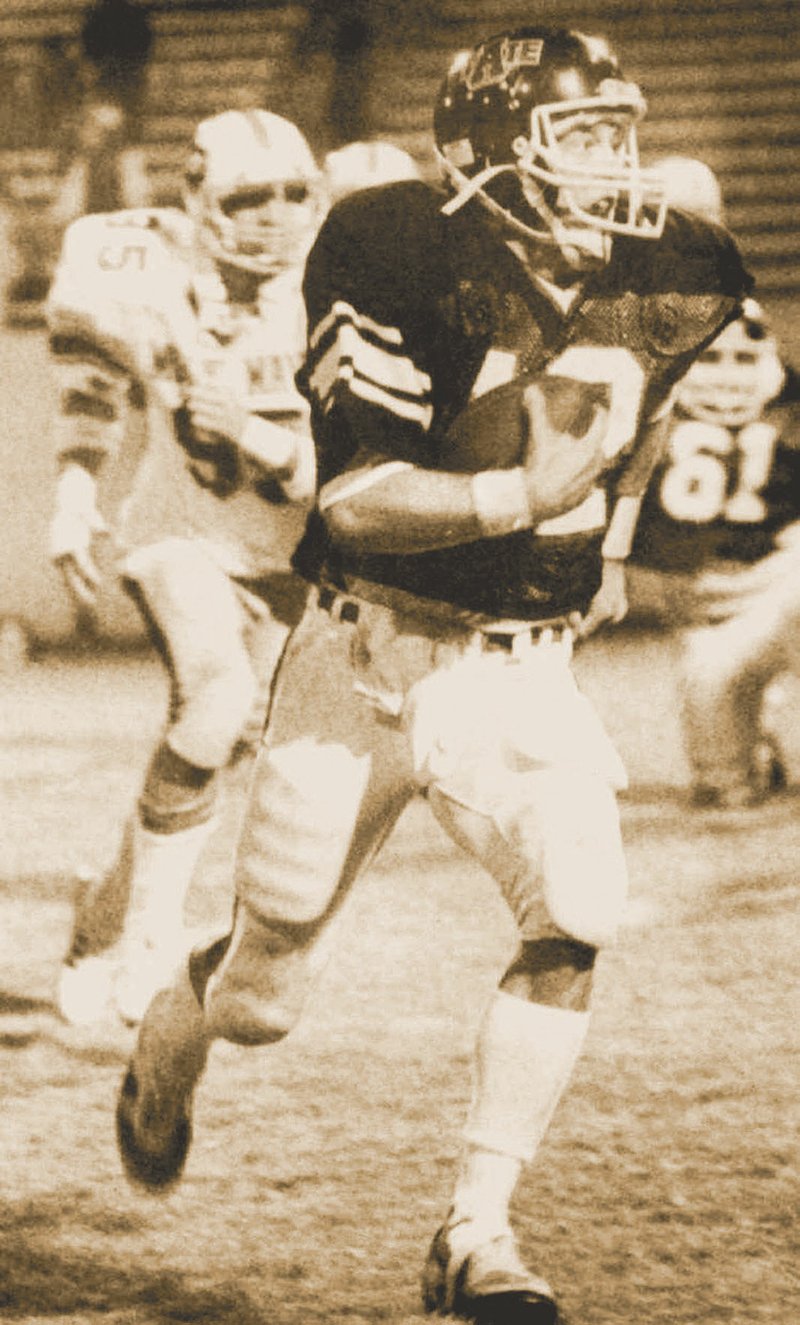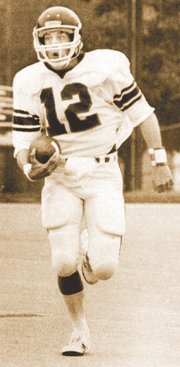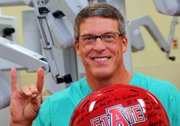Tim Langford struggled to find the right emotion for being included in the Arkansas Sports Hall of Fame.
The former Arkansas State University quarterback who grew up in Searcy and is now a Little Rock urologist is grateful for the honor. But without much trouble, Langford can tick off plenty of players he believes are more deserving.
Tim Langford at a glance
COLLEGE Arkansas State, 1980-1983
POSITION Quarterback
HOMETOWN Searcy
AGE 56 (Born Oct. 1, 1960)
FAMILY Wife Terri, Children Aaron, Brian and Caitlynn
NOTEWORTHY Langford was ASU’s total offense leader three consecutive years and ranks 13th on ASU’s all-time yardage list at 3,745 yards. … Earned second-team All-Southland Conference honors in 1983. … Inducted into ASU’s Hall of Honor in 2008. … Donated funds for the Tim and Terri Langford Sports Medicine Center at ASU.
There's Jerry Muckensturm, an ASU linebacker in the 1970s who went on to play for the Chicago Bears. And there's Dwane Brown, the quarterback of ASU's 1986 team that played for the Division I-AA national title.*
"You're a little embarrassed when you see guys like that not in," Langford said. "I never thought I'd be in the Hall of Fame, or even deserve it."
Langford wasn't the quarterback on ASU's best teams. Then known as the Indians, ASU went 18-25-1 in 1980-1983 and had a winning record only once, a 6-5 finish in 1981. Langford's statistics don't rank among ASU's all-time greats, either. He's 13th in career total offense at 3,745 yards.
But Langford made an impression. He helped lay the groundwork for some of ASU's greatest teams. Starting with an 8-4 finish in 1984, ASU won eight or more games in the four seasons immediately after Langford departed, including trips to the I-AA playoffs in 1985, 1986 and 1987.
"He made us look good," said David Mitchell, ASU's running backs coach while Langford was running its option offense. "We had to coach it, and they had to execute it, but it allowed high school kids to say, 'Man, they know what they're doing.' "
In recent years, he's made his biggest contributions as a donor. Since 2014, he has served on ASU's board of trustees.
"If we had 500 or 1,000 Tim and Terri Langfords, we'd be Texas," ASU Athletic Director Terry Mohajir said.
Langford's reasoning for giving back to his school -- after a period in the 1990s in which he said he "lost touch" -- is easy.
"That school did so much for me," he said. "I just gained a lot of confidence as a person, going through all those losses. Even though it was tough, all those practices and injuries, I really learned a lot. Nothing in life was going to be tougher than what I went through."
The connection occurred almost randomly.
Langford, the son of an insurance salesman, was an undersized quarterback at Searcy High School in the late 1970s who drew interest from the Arkansas Intercollegiate Conference schools. He took a trip to Cornell University, and his dad drove film of his playing highlights to Alabama, but nothing ever came of that.
ASU was the only Division I school to offer him a scholarship. The school had just hired Larry Lacewell from Oklahoma, and offensive coordinator George Smith promised a passing offense.
His career encompassed three offenses run by three different coordinators, and the Indians never gained much traction. They went 2-9 in 1980, then 6-5 in 1981, when a penalty for too many men on the field marred a 17-16 loss at the University of Kansas and was capped by a 31-7 victory over University of Tulsa.
"That gave us a lot of positivity going into the offseason," he said.
But they went 5-6 in 1982, losing conference games to Northeastern Louisiana University, McNeese State University, Louisiana Tech, and a nonconference game at Memphis.
Langford said the Memphis loss was so deflating, he almost didn't play his senior season. He already had been accepted to medical school and could have earned his undergraduate degree and move on. But he stuck around when Lacewell promised a move to a Flexbone offense that included more passing.
ASU stumbled to a 2-4 start before beating Louisiana Tech and McNeese State. After a loss to the University of Texas-Arlington on senior day when Langford rushed for 127 yards and passed for 161, ASU beat Lamar to head into a season finale at Memphis with a chance for a winning record.
The Indians were ahead 14-7 when Langford took a shot to the ribs. He later found out he broke some of them.
He told Lacewell he could stay in the game but he couldn't throw. In the closing minutes, Langford rolled to his left to throw, but the pass was intercepted, returned for a touchdown and his final game ended in a 14-14 tie.
"I told Coach Lacewell that I was sorry," Langford said. "I never saw him cry, but he broke down and cried and said 'Sorry? You staying this fifth year probably saved my job.'
"You could see us improving. And then they took off after that."
Langford went to medical school at the University of Arkansas for Medical Science. After Lacewell departed in 1989, Langford said he lost touch with his alma mater. The on-field struggles didn't help -- from 1989 to 2011, ASU had one winning season -- but he also felt like there was no effort from the program to connect with past players.
Langford credits Dean Lee, athletic director from 2002-2012, and Steve Roberts, the coach from 2002-2010, for re-establishing those connections. He and his wife, Terri, started going to games, and in 2004, he donated $250,000 for a sports medicine center at the football complex.
His support has not waned since.
"He embodies everything that we're trying to do for our current student-athletes, and that is to have success after their playing career is over," Mohajir said. "He is the model for that."
Langford remembers following Lacewell's most accomplished teams while in medical school. He watched the loss to Georgia Southern in the I-AA title game on TV in Little Rock. He thinks what's happened recently might eclipse the excitement from then.
ASU has at least a share of the Sun belt title in five of the past six seasons and has reached six consecutive bowl games. With Langford's help, Centennial Bank Stadium has been upgraded with an indoor practice facility and the Johnny Allison Tower, a collection of suites and club seating that has provided a new source of revenue.
Talks for a renovation to the north side of the stadium are ongoing. Langford, on the ground floor of the recent progress, takes more satisfaction in that than anything he did as a player.
"There's no no doubt that I've made more of an impact as an alumnus than as a player," he said. "I never considered myself a great player. But, for me, I think there is more of an impact and the possibility is greater doing it as a donor, and as a fan, and as a supporter."
Sports on 02/24/2017
*CORRECTION: Ray Brown, an offensive lineman at Arkansas State University who played 19 seasons in the NFL, was inducted into the Arkansas Sports Hall of Fame in 2006. A previous version of this article incorrectly stated he was not a member.


